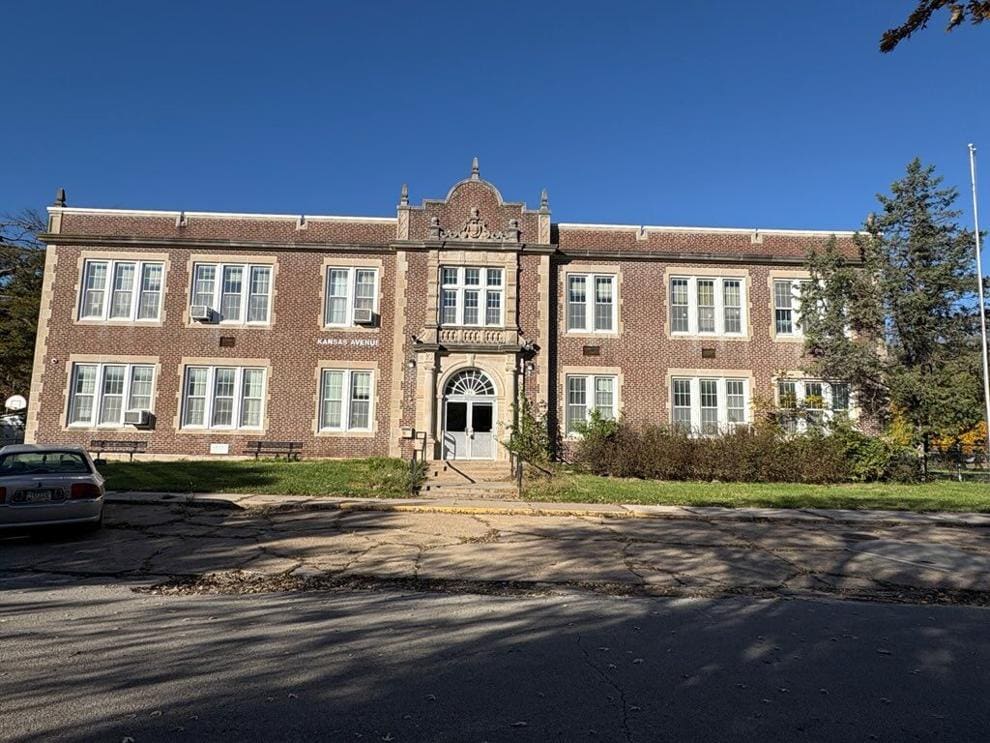Published on December 1st, 2019
By Preserve Manhattan
Nestled in a downtown neighborhood known as one of Manhattan’s “First Neighborhoods” is a historic apartment building known as the Avalon. Located at 417 Fremont Street, the building was previously listed on the Register of Historic Kansas Places and was recently added to the National Register.
Built in approximately 1890, the structure originally was a nine-room brick private residence. The exact construction date is unclear, as the property changed owners a number of times between 1885 and 1895. James W. McDonald purchased the house in 1907, and the McDonald family resided there for the next 14 years. The McDonalds sold the house to Landrine Sheriff in 1921 (National), and a short newspaper notice stated, “Mr. Sheriff . . . is now having the house remodeled and will have it made into apartments” (“Mr. Sheriff”).
It’s possible that the house’s conversion to apartments wasn’t completed because a notice in a 1923 newspaper indicates the house was purchased by Morley P. Robinson. Mr. Robinson operated the Robinson Motor Company, which sold automobiles as well as tractors, threshers, and other farm machinery (“New”). Morley sold the building to his son Harold Robinson in 1931, and Morley and his wife continued to live in one of the apartments, which is a possible indicator that the conversion to apartments was completed around 1925 (National). Morley’s daughter Ethyl Robinson married in 1926, and the description of the wedding indicated the ceremony took place at “the Avalon” and stated the
newlyweds would reside at the Avalon (“Robinson”). This appears to be the first time the building was
referred to as the Avalon Apartments (National). The west portion of the building is the section that was originally the nine-room private residence, and its design was replicated to create the eastern half when the building was expanded and converted to apartments. Stucco was applied to the entire structure, and its overall design reflects the Prairie School style of architecture (National). Following World War I, the nation experienced a housing crunch as people migrated to towns and cities in search of more opportunities. Many people lacked the resources to purchase their own homes, and apartments provided an affordable alternative for many families (National). The Robinsons likely saw the financial value in converting the building to apartments to help address the housing demands.
Over the years, a number of prominent Manhattan residents have owned the Avalon, including Joseph Floersch, who would go on to be the president of the Union National Bank; Mollie Goldstein, who was a member of the Goldstein family that owned Kansas Wool and Hide, which was a precursor to Steel and Pipe Supply Company; and Herbert Gaede, who managed Duckwall’s (National). Today, the Avalon is owned by FHP Properties LLC, which is owned by Tyler and Morgan Holloman. Tyler and Morgan purchased the building in 2018, and Tyler says the building’s unique features and distinctive architecture attracted them to the property, especially the front façade with its two-story stacked porches. When they purchased the nearly 130-year-old building, it was not in top notch condition and was in need of
extensive renovations in order to make it code compliant as well as safe for tenants. The owners pursued historic registry listing for the Avalon, working with Spencer Preservation to develop the register nomination. Tyler says they wanted to ensure that the building would be historically maintained for future generations, and registry listing would help to accomplish that. They also sought rehabilitation tax credits, which are available for properties on the historic register. The Avalon was eligible for both state and federal tax credits, and both were used to help with the renovation expenses.
Tyler and Morgan wanted to maintain the distinctive arched front porches, but the porches’ footings were failing. In order to save the porches, the footings had to be rebuilt. Interior arched doorways were also maintained and repaired as needed. All of the hardwood flooring in the Avalon was retained and restored. Interior millwork and casings were saved whenever possible, and all of the original interior doors were retained.
In the more than 90 years since the building was converted to apartments, the building’s footprint hadn’t changed, and there have been few alterations to the exterior. One of the exterior changes involved the rear porches. Originally, the building had rear one-story porches, and many years ago, the porches were expanded to two stories. At some point in the past, the porches were converted to kitchen space to enlarge the kitchens (National). The apartments’ kitchens were completely remodeled during the current renovation. Rear exterior stairs were also completely rebuilt.
Since Spencer Preservation had researched the property, Tyler and Morgan were aware that the Avalon had originally been a nineroom brick private residence. During renovation, however, they were surprised to discover that the original brick section of the structure was not wood-framed with a brick veneer. Instead, the brick walls were 16 inches thick in order to provide adequate structural support for a two-story home. A portion of the rear wall of the brick section had begun to fail due to water damage. A structural engineer was consulted, and extensive repairs took place in order to shore up the wall and keep it intact. Other renovations included new electrical and plumbing, and an old boiler was removed.
In total, the renovation project took approximately one year to complete, plus another six months devoted to the purchase process and the development of renovation plans. In addition to Spencer Preservation, others who worked on the project included Frontier Construction as the contractor, and Heather Peterson provided design services for the project. Tyler says Frontier Construction was instrumental in ensuring that the renovation project complied with historic regulations and also with city requirements.
Tyler says his favorite thing about the renovation project is the positive comments he’s received from the community since its completion. Many people noticed the work going on and the dramatic improvements, and they have expressed their pleasure in seeing the historic Avalon Apartments restored.
In the future, there are plans to provide additional landscaping in the spring, which will complete the transformation of the historic Avalon Apartments.
“Mr. Sheriff.” The Manhattan Nationalist. 6 April 1921: 3
National Register of Historic Places, The Avalon, Manhattan, Riley County, KS.
“New motor car firm here.” The Manhattan Republic. 14 June 1923: 8.
“Robinson-Berry wedding.” The Morning Chronicle. 30 October 1926: 3.
Source: https://www.preservemanhattan.org/uploads/8/0/7/7/8077603/december_2019_newsletter.pdf

